By Eric Vandenbroeck and co-workers
The Holy Roman Empire, the Reformation,
and the birth of the Netherlands
The Holy Roman Empire
was created by joining in personal union. With the imperial title the crown of
the Kingdom of Italy with the Frankish crown, notably the Kingdom of East
Francia. Soon these kingdoms would be joined by the Kingdom of Burgundy and the
Kingdom of Bohemia. By the end of the 15th century, the empire was still
composed of three major blocks. Later territorially, only the Kingdom of
Germany and Bohemia remained, with the Burgundian territories lost to France.
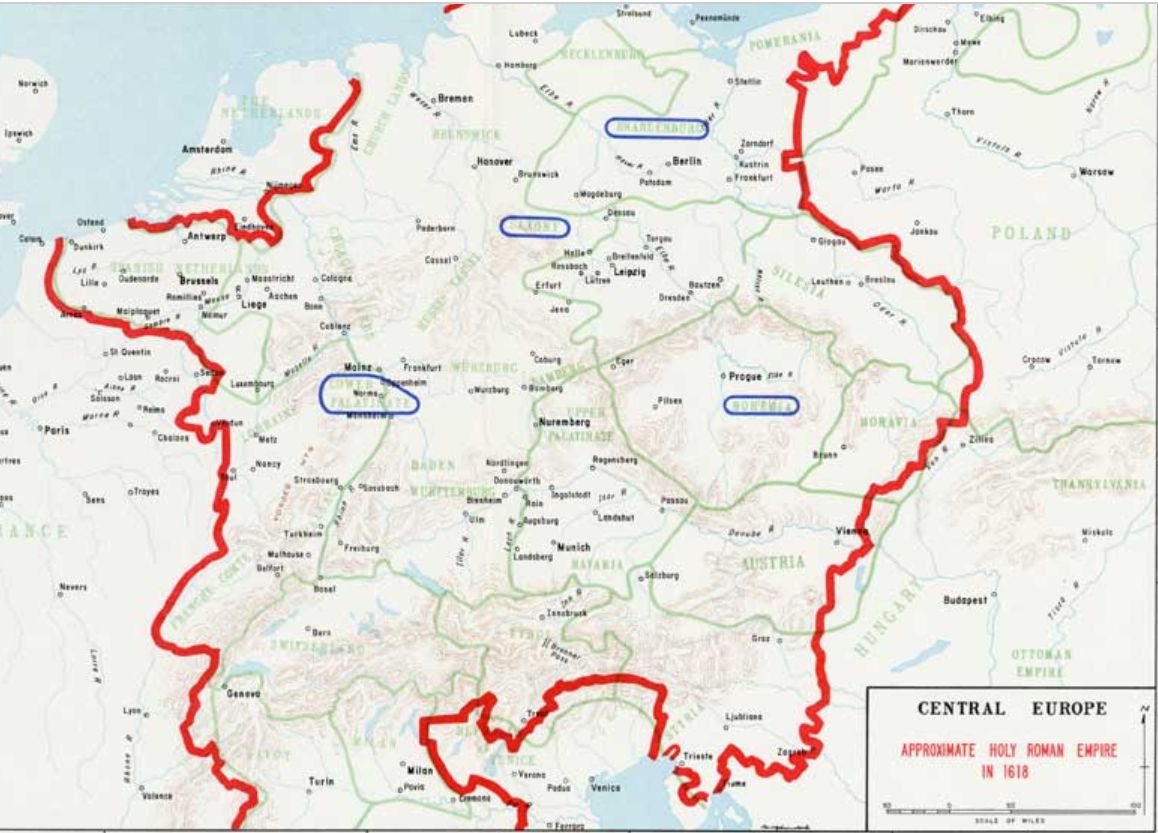
Voltaire observed
that the creature that called itself and still calls itself the Holy Roman
Empire is in no way holy, nor Roman, nor an empire. But in Voltaire’s time, it
was also somewhat unfair. The empire that went by the name of the Holy Roman
Empire did not aspire to be the sort of empire Constantine would have
recognized, a product of conquest and war, with centrally appointed ministers
reporting up a bureaucratic chain of command.
The empire Voltaire
described had initially been created through an agreement between the Frankish
king, Charlemagne, and Pope Leo III, in 800. Leo had refused to accept the
authority of the empress Irene, who, after deposing her son and taking power
for herself three years before, now ruled at Constantinople. After several
vicissitudes, the empire as it existed in 1500 had descended from a meeting
(called a Diet) of lords, which, in 1356, issued a charter known as the Golden
Bull. The point of the Golden Bull was to establish the terms under which a
college of seven electors, three of their bishops, would elect a new
emperor.
The terms of the
Golden Bull make it clear that imperial authority depended upon the agreement
of the essential members of the imperial aristocracy, whose own head was
negotiated with leaders in the territories they controlled. It would have been
at this point that the spirit of Constantine if it had come visiting, would
have given up in disgust. The fact that the emperor was elected, much as it
would have appalled Constantine, will be significant for understanding how the
Reformation began.
The Holy Roman
Empire’s biggest problem was not lacking holiness or Romanness
but rather the absence of a coherent bureaucratic government. As the core of
Charlemagne’s empire passed to the kings of France, the German lands to the
north remained under the control of emperors who essentially split their time
between Germany and Italy, negotiating and renegotiating their power with the
papacy as well as their sundry vassals.
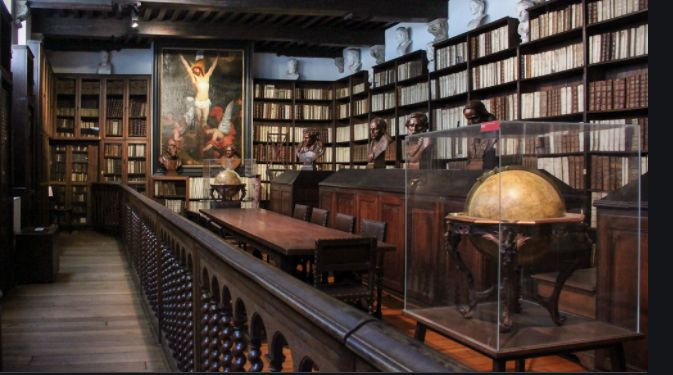
In 1440, with the
election of the first member of what would become the longest-serving dynastic
group, the Habsburgs, to hold the throne as emperor, there began to be serious
efforts to make the system work better. Frederick, the second Habsburg emperor,
settled the formal relationship between the papacy and the empire through the
Concordat of Vienna in 1448. The two parties agreed that the emperor could
influence the selection of senior clerics in his territory. At the same time,
the pope would retain the right to collect taxes from Church lands and
determine matters of theological importance. The corollary of this arrangement
was that local princes began to assert greater control over Church hierarchies
in their bailiwick.
The settlement with
the Church by no means solved all of Frederick’s problems. In 1457, Frederick,
whose central European base was in Austria, tried to stabilize direct control
over Hungary and Bohemia, still a stronghold for followers of Jan Hus. His claim
was rejected. When he attempted to assert authority by force of arms, he was
defeated. He essentially withdrew, leaving power to his son Maximilian, whose
election as “king of the Romans” in 1486 marked him out as the heir
apparent.
In late Oct. 2019,
titled “For Maximilian, I, the emperor at the heart of “The Last Knight,” armor
was as much for propaganda as protection.” Titled in the exhibition “The
Last Knight: The Art, Armor, and Ambition of Maximilian I” at the Metropolitan
Museum of Art:
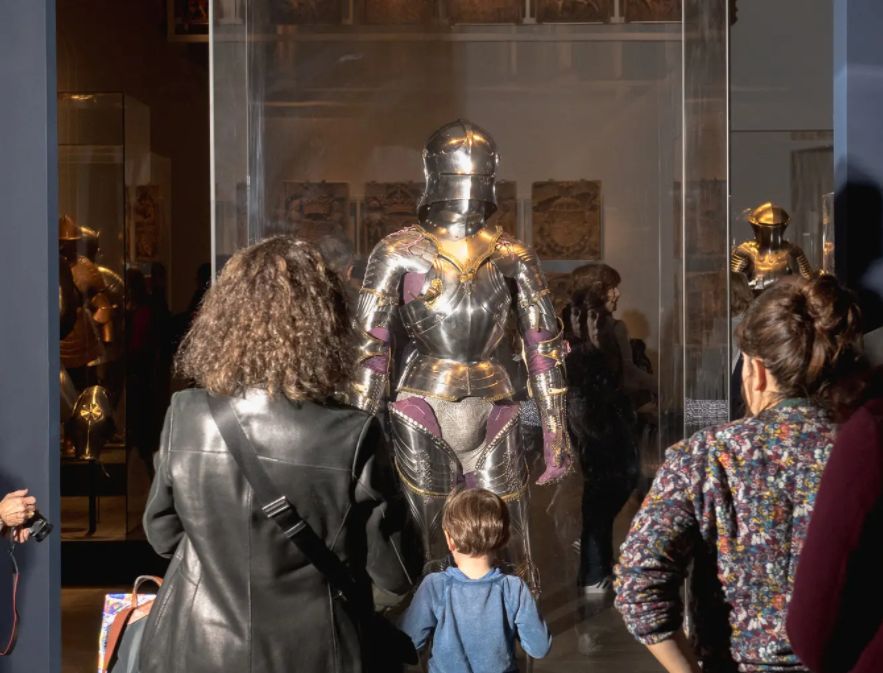
A better diplomat
than his father, Maximilian earned considerable goodwill by acting as a buffer
between his father and the numerous princes who opposed him. He exploited the
goodwill he’d earned by summoning an Imperial Diet at Worms in 1495. Maximilian
used this occasion to declare a
universal peace and establish a new imperial court to handle disputes
between his vassals and a new regional administration system. Additionally,
Maximilian introduced more centralized systems of taxation. Ideally, this would
supplement or replace the existing system of taxation through which vassals
were assessed contributions for imperial defense. The problem with this system
was that it meant people had to own up to what they had, while the old system
allowed them to state their worth and use it to provide troops’ levies or
contributions of cash to the imperial treasury instead of soldiers.
A more efficient tax
system was increasingly crucial because the war was getting a great deal more
expensive. The Turks had taken Constantinople, in part, because they had a
large artillery train that allowed them to batter the city walls into rubble.
Artillery required professionals who could handle the basic math necessary to
construct and fire the guns. Also, as Turkish armies ran into traditional
feudal armies, the result was routinely catastrophic from a European
perspective (it is fair to say that the early Ottoman interests in securing the
Middle East spared the empire an invasion it might not have been able to
resist). War had to professionalize, and it did so through the development of
increasingly influential bands of professional military contractors who were
now used mainly against each other as the emperor sought to enforce his
control, usually against French opposition, in northern Italy. The emperor
Maximilian spent vast sums of money on wars in Italy that began in 1494 and
lasted throughout his reign.
The princes of
Germany were just as aware of these facts as was the emperor. They rapidly shed
his preferred system of taxation for the older contribution system. If they
were to remain factors in the brave new world of military contracting, they
needed to husband their resources.
The fact the powerful
needed money created problems for the poor. Throughout southern Germany,
peasants found that access to what had previously been common land was being
restricted. They were prevented from gathering firewood, that new services were
demanded, and that new regulations were being imposed upon them. The bitterness
engendered by these circumstances reached a boiling point when the Church
discovered that it needed even more money for its purposes in the decades after
1500 and sought to suck that money out of Germany for use in its Italian
heartland.
As we approach the
fatal year 1517, the year Martin Luther would post the ninety-five theses that
sparked the Reformation, there are three characteristics of the Holy Roman
Empire to bear in mind:
1. Power had to be negotiated between the emperor and his
subjects.
2. Princes had a say in the religious organization of
their territories.
3. Money was in short supply for everyone.
The Reformation and the city of Antwerp
The Church Martin Luther
would challenge asserted its power through its control of two ways of reckoning
time. One way was cyclical, featuring a calendar based on annual festivals
celebrating the life and ministry of Christ. The other was linear, based on
sacraments that defined a person’s relationship with God at various points
during their life.
Martin Luther was a
complex man. He had a bad temper and was exceptionally confident in his
convictions. He was also possessed of unusual energy and courage.
Yet, the spread of
print books soon gave rise to a new phenomenon as the fifteenth century turned
into the sixteenth: the public intellectual. For the better part of the
previous century, a small group of dedicated scholars, calling themselves
humanists, had been recovering classical texts and, using their newfound
knowledge of the past, had started to shape intellectual discourse. The most
influential of these figures in the early fifteenth century was Poggio Bracciolini and Lorenzo Valla. Poggio took it upon himself
to “rescue” copies of classical texts buried in monasteries of southern Germany
and France, having new copies made. He asserted that the study of human letters
was a new area of learning. Valla took a different view, whose accomplishments
included a Latin translation of Thucydides’ History of the Peloponnesian War.
He believed humanistic studies should be used to correct errors in the
Christian tradition. One example was a stunning demonstration that a document
known as the Donation of Constantine, which recorded Constantine’s proclamation
of the pope as the leader of the Church, was an eighth-century fake.
Despite their
disagreements and ecclesiastical connections, Poggio and Valla showed that
intellectual life need not depend on the Church. With the newfound taste in
books that could guide life, new opportunities opened up for a new generation
of intellectuals. Chief among these men was Desiderius Erasmus, who was
unquestionably Europe’s most famous intellectual by the first decade of the
sixteenth century. It was undoubtedly Europe’s most prominent academic was
unquestionably Europe’s most famous intellectual the sixteenth century, the
city of Antwerp-in books and in cloth. It was also—as were all the lands that
now form Belgium, Holland, and Luxembourg, a part of Charles V’s empire. Once
the possession of the dukes of Burgundy, these lands had passed into the Holy
Roman Empire after the death of the last duke, Charles the Bold, in 1477.
Charles the Bold in
about 1460, wearing the collar of the Order of the Golden Fleece, painted by
Rogier van der Weyden:
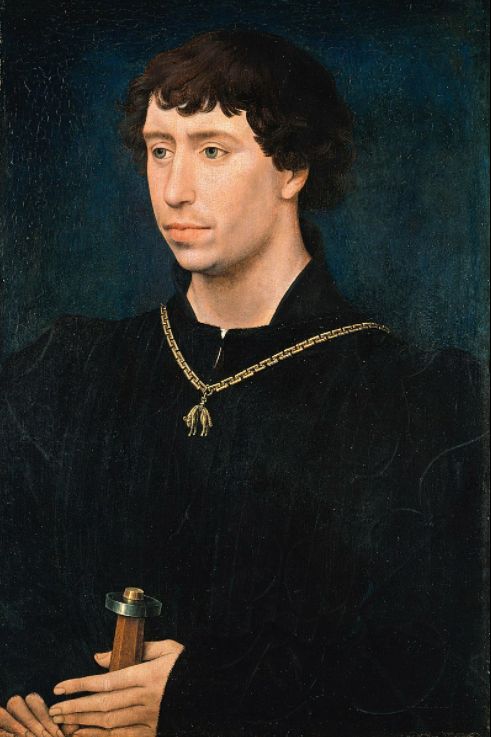
In 1363, Philipp von
Valois founded the House of Burgundy as a sideline of the French royal family
of the Valois. This House of Burgundy relied on extensive territorial
expansion, which led to an intermediate empire between France and the Holy
Roman Empire, the southern part of which was the old Duchy of Burgundy and at
times the Free County and the northern part of which was the Netherlands. After
the death of the last male duke from the House of Valois, Charles the Bold,
this rulership complex was divided in the Burgundian Wars (1477). Through the
marriage of Maximilian to the heir to Charles the Bold, Maria of Burgundy, the
House of Habsburg secured the (economic this rulership complex was divided)
most important parts of tree County.
And of course, the earliest followers of Jesus (believed the
long-promised ‘king of the Jews were Jews. The church was predominantly Jewish
until after the first major war with Rome (A.D. 66-70), and not until after the
catastrophic Bar Kokhba war (A.D. 132-135) did the Jewish church of
Jerusalem come to an end, and a Gentile bishop succeeded the Jewish bishop
there. Many centuries before the Ebionites Jewish Christians) would
finally cease as a distinct and viable denomination within Christianity.
Accordingly, for Jewish and Christian scholars today, the origins of Judaism
and Christianity constitute a complex and interesting story whose interwoven
threads should not be unraveled. Ironically, the mighty Roman Empire, which
smashed the state of Israel in a series of punishing wars (from A. D. 66-135),
was itself overrun by a messianic faith rooted in Israel’s sacred Scriptures
and its ancient belief in the God of Abraham. All of this would be put once
more on its head during the Reformation as new ways were searched for.
Pictured below is
Maria of Austria (1528-1603), the daughter of Charles, who was the wife of
Maximilian and Charles V’s mother:

The former lands of
Charles the Bold had been divided into seventeen provinces, of which seven were
north of the Rhine. Dutch was the primary language spoken in these areas,
unlike the rest of Europe, where feudal forms of governance had never taken
hold. The ten provinces south of the Rhine were Flemish. The major cities
within each region maintained “ancient privileges” conferred upon them by the
dukes of the past, as here too, feudal traditions had largely evaporated. These
provinces had more excellent traditions of self-government. Among the most
important aspects of civic government were that cities had the power to
determine who was a citizen, the autonomy of their courts, and the right to
elect their administrators. Another difference from most of Europe is that
these provinces had elective assemblies known as states. In the middle of the
fifteenth century, the dukes of Burgundy had begun to summon an assembly of all
the states, known as the States-General.
Charles V had been in
Antwerp while he prepared to take up his position as emperor and was somewhat
uncomfortable with the independence of the people he found there. Indeed, his
decision to order the mass incineration of Luther’s works, widely read in Antwerp,
may have been as much a statement about the people of Antwerp as it was a
statement about Luther, toward whom his behavior would be more restrained.
The printing presses at the Plantin Moretus in Antwerp:
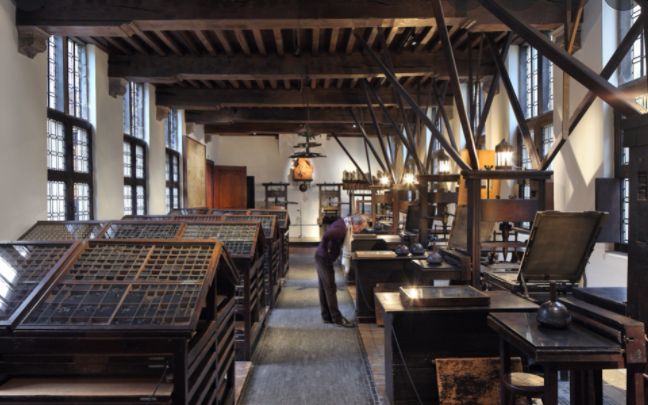
Plantin himself or
his son-in-law Jan I Moretus may have been familiar
with these two presses from around 1600. They have had an eventful career and
are the oldest preserved printing presses in the world.
Thomas More was not
the only nonconformist who found a Belgian publisher. On the far side of the
North Sea, he regarded as dangerously heretical works from Antwerp. The area
itself was soon home to Tyndale and Simon Fish. Their violently
anti-establishment The Supplication of Beggars drew forth from More’s
Supplication of Souls, the work in which he laid out a grisly vision of the
torments imposed on the souls in Purgatory.
Despite Charles V’s
hostility, publishers in Antwerp continued to print Luther’s writings. The fact
hundreds of copies were burned between 1520 and 1522 shows how popular they
were. There were various reasons for this popularity. One was the humanist movement,
which had shaped and spawned greater literacy levels than elsewhere in Europe;
another was the generally greater sophistication of the region’s well-developed
urban society. Yet another was the introduction of early forms of capitalism
connected to the area’s thriving cloth trade, brewing, and bulk trading, as
well as its publishing industry. Economic change was loosening the vertical
bonds that had kept people in complete submission to their overlords. Within
this setting, persecution of pro-Lutheran publishers around Antwerp drove them
a bit further north to cities like Leiden and Amsterdam. At the same time,
persecution of individuals rounded up by the Inquisition, which Charles had
dispatched to the region, fanned the flames of discontent.
Initially, the
steadfast loyalty of the area’s administrators to Charles V prevented any
reformation along the lines of what was occurring in Germany or Switzerland.
Lutheran sympathizers learned to keep their views to themselves. The lack of a
publicly organized reform movement opened the door to extremists (chiefly
Anabaptists) shunned or persecuted in Protestant lands. By the 1530s, there was
a distinct division between crypto-reformists of a Lutheran stamp and activist
Anabaptists, whose rejection of the validity of infant baptism was generally a
feature of a wholesale rejection of societal norms, which included a
willingness to experience a hideous death for their beliefs. One hundred
thirty-nine of the one hundred sixty-one persons executed for heresy at Antwerp
between 1522 and 1565 were Anabaptists, as were fifty of the fifty-five
individuals committed at Ghent.Prior to Luther’s
translation, most Europeans encountered the Scriptures through the Latin
Vulgate translation. Two differences in how these Latin and German Bibles
translate Jesus’ words in Matthew 5:32 and 19:9 may help explain how
Anabaptists (and other Reformers) diverged with Roman Catholic
views on divorce and remarriage.
Not every Anabaptist
wanted to die a painful death. As the 1530s ended, the further one was from
Antwerp, the more likely it was that an Anabaptist could survive and behave in
less overtly antisocial ways than had the reformers of Munster. Two men, in particular,
stand out, Menno Simons and Dirk Phillips, whose more pacific form of Anabaptism
was spread through publications in Dutch. When Calvinist preachers began to
arrive in the area in the 1540s, they found that much of the population had
turned from the Catholic Church, and most people were finding ways of
concealing their true thoughts from the authorities. The literature that
accompanied their arrival stressed subordination to the will of God, the notion
that martyrdom was a supreme act of faith, and that God ordained the authority
of princes. People were not yet ready to explore the implications of ordained
the authority of princes Christian Religion, that minor officials in ancient
states, such as the tribunes in Rome, had been appointed to limit the power of
kings, and that there might be a similar power inherent to assemblies of the
three orders of society (the three orders being the clergy, nobility, and
commons). That view, which challenged the notion that God sanctified royal
power, would ultimately become Calvin’s most important intellectual legacy
blessed royal power. In the 16th century, Mechelen ruled the Low
Countries. The city fulfilled the function of the administrative capital of the
Netherlands (established by Margaret of Austria, whose statue is seen below in
the center of Mechelen).
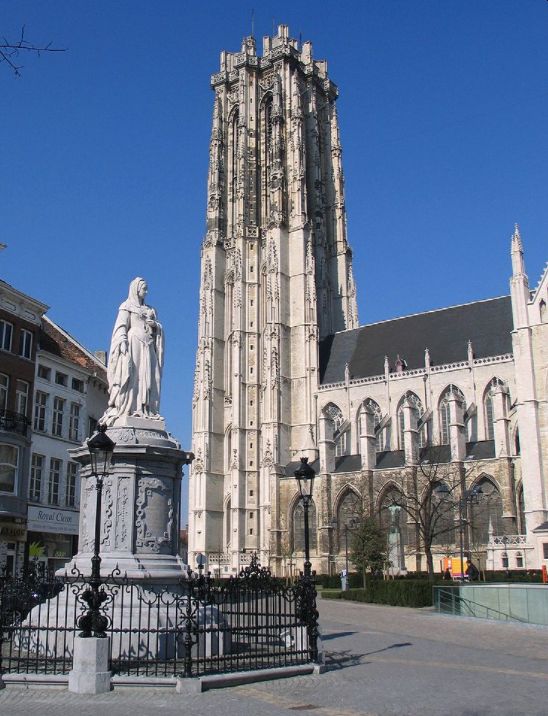
The late 1540s and
early 1550s witnessed a newly aggressive effort to counter the reform movement.
The Catholic Church reformed itself at the Council of Trent between 1545 and
1561 and promoted a new, intellectual response through the Society of Jesus (better
known as the Jesuit order), founded in Paris in 1541 by the Spanish priest
Ignatius Loyola. On the battlefield, Charles V won a smashing victory over the
forces of the Schmalkalden League at Mühlberg in 1547. In 1553, Henry VIII’s
older daughter Mary, a devout Roman Catholic, succeeded her brother Edward VI
(a firm reformer) as ruler of England. The lesson Charles and his soon-to-be
successors, Ferdinand in the Holy Roman Empire and Philip in Spain, should have
taken away from the battle of Mühlberg was that there was no going back.
Charles found he could not exploit his victory and finally conceded the point a
year later at yet another Council of Augsburg, agreeing that Protestant princes
could continue to rule their lands until the Council of Trent finished its
work.
Below Mary
Tudor. Painted in 1554 by Anthonis Mor, who was assigned to the task by Charles
V. This painting was done while negotiations were in progress for Mary’s
marriage to Philip V of Spain:
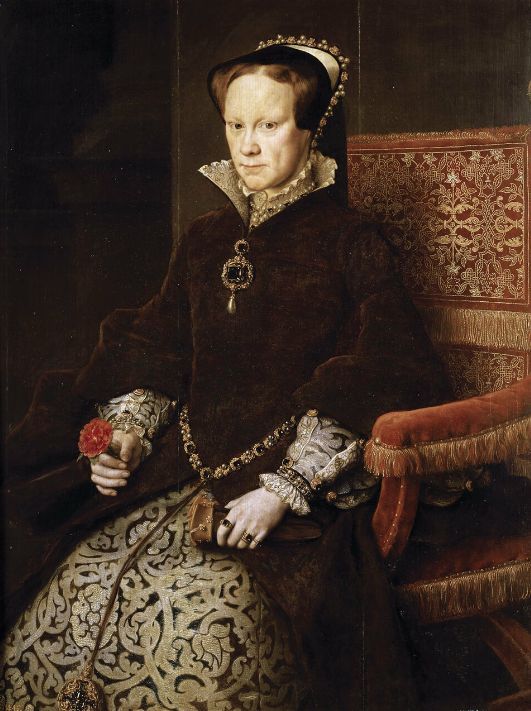
Charles’ moderation at
Augsburg was not matched by conduct in England or the Netherlands. When she
took the English throne, Mary adopted a rigid ideological line and tried to
undo Cranmer’s reforms, which had put down deep roots in the six years of her
brother’s reign. Cranmer was but one of the numerous victims of her efforts to
restore the old Catholic ways. Rather than die at stake, many intellectuals
fled to Switzerland and elsewhere, the Netherlands included. The years of
repression, associated with the queen’s marriage to Philip II, had the effect
of linking religious reform with national identity. When Mary died in November
1558, renewed reform returned with her half-sister Elizabeth (Figure 3.6).
Indeed, Elizabeth’s religious views, always malleable according to circumstance,
were less staunchly in favor of reform than those of the advisers who pushed
the reestablishment of the national, but notably not Calvinist, Church in the
immediate aftermath of her succession. The key figures of this era were members
of the newer nobility. They tended to be as hostile to what they perceived as
socially disruptive doctrines from Geneva, such as the democratic election of
Church leaders, radical changes in the liturgy, and the notion that society’s
leaders had to act responsibly in their dealings with their social inferiors,
as they were to Catholicism. That would change, but not until the issues
dividing Protestant from Catholic had reached new levels of violence on the
continent.
The “Coronation
Portrait” of Elizabeth I, by an unknown artist, makes a point about the
legitimacy of her claim to the throne:
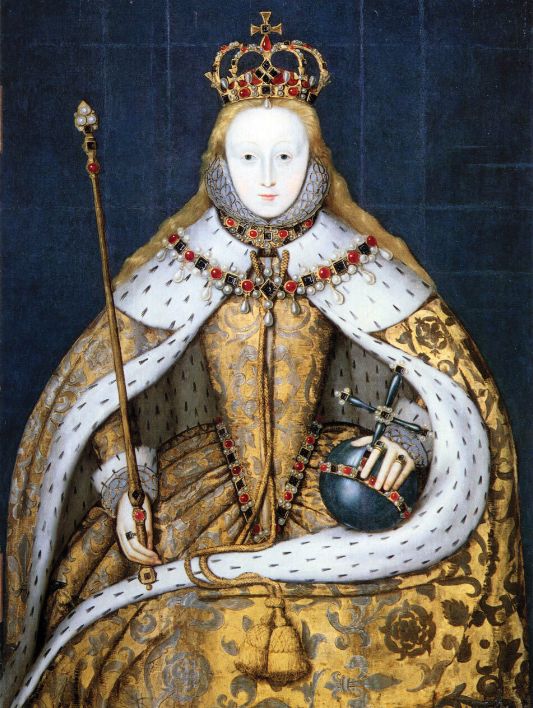
In 1549, Charles had
taken a significant step toward centralizing imperial authority in the former
Burgundian landstooking the “Pragmatic Sacentralizing the government of all seventeen provinces
while sating that each region would retain its ancient privileges. Just how
that was supposed to work was never made clear. The hamfisted
actions of Philip II, who succeeded as ruler of the area when the exhausted
Charles abdicated in 1556, created immediate tension.
Philip had been
excluded from any claim to the English throne by the terms of his marriage to Queen
Mary and was tied up with a war against France as his wife lay dying. Now,
operating from bases in Belgium, he won a significant victory over the French.
Unfortunately, he had not learned the lessons that had gradually dawned on his
father, who had died a few months before Mary, namely that battlefield victory
rarely led to political success and that all power had to be negotiated.
In the long run,
pretty much the only thing Philip gained from his treaty with France was an end
to the expense of fighting a war. The cost of the war had put a severe strain
on his relations with the local nobility (especially those based north of the Rhine)
who had been called upon to pay for it. Philip was somewhat suspicious of this
group, as he sensed that they were unenthusiastic about Catholicism. So it was
that when he returned to Spain, he divided the government of the region between
his half-sister Margaret (the result of an illicit affair between his father
and a palace servant many years before), who ruled over the ten southern
provinces, and William of Orange, a local notable, who was granted the seven
northern provinces. William, whose father was the duke of Nassau, a territory
in the heart of the modern Netherlands, had obtained princely status when his
uncle, prince of the region of Orange in southern France, had died in
1544.
William, also known
as William the Silent because of his ability to conceal his true thoughts from
those he dealt with, was cautiously supportive of the Calvinist tendencies
among the people in the regions under his charge. This was even though he had
been given a solid Catholic upbringing as one of the terms of his inheritance
of the state of Orange. Before his appointment in 1559, he had also been among
Philip’s favorites.
The tensions between
Margaret’s Catholic administration and the sentiments of William’s subjects and
those of other nobles led to rifts within the governing group in the years
after Philip. Simply put, Mary’s court’s inquisition into the religious beliefs
of the people of the seventeen provinces seemed an outrageous violation of the
principle that the states would retain their ancient privileges. Detesting
Antoine Perrenot de Granville (1517-1586), minister
of King Philip II of Spain, he played a significant role in the early stages of
the Netherlands’ revolt against Philip’s rule.
Margaret’s chief
minister and manager of the Inquisition, William, became increasingly outspoken
in his opposition to the active repression of reformers, which he blamed on de
Granville.
At the same time that
William was attacking de Granville, a new theme began to emerge in contemporary
literature. In 1557, for instance, Peter Dathenus
published a book entitled Christian Account of a Dispute Held within Oudenaarde. He argued, following Calvin, that while good
Christians should be subordinate even to tyrannical authority, lower secular
magistrates had a duty to resist tyrants. Five years later, Protestant
ministers gathered at Antwerp and stated that it was permissible to break
co-religionists out of jail. A year earlier, Guy de Bray, a minister at
Antwerp, while arguing that all people should obey their princes, boldly
claimed that princes should avoid persecuting people for their faith. A
contemporary, Pieter-Anastasius Pieterszoon Overd’hage de Zuttere (born 1520
in Gent, died 1604 in Leiden), stated that the government should limit itself
entirely to secular affairs. These views accorded well with those of civic
magistrates who were concerned about what they saw as wholesale violations of
their ancient privileges.
The writings of de
Bray and Zuttere articulated the
issues lying behind the bold statement that William of Orange made at a meeting
of German princes in 1564, that monarchs should not rule over the souls of
their subjects (a point that was likely just as shocking for Protestants as it
would have been for Catholics). He then joined a protest against religious
repression launched by notables of his region in 1565. Protestors maintained
their loyalty to Philip while objecting to the conduct of his officials. There
was worse to come.
In 1566–1567,
widespread rioting broke out in Antwerp and rapidly spread throughout the
region as mobs began destroying religious images in churches. There were
occasional efforts on the imperial authorities to suggest that the mass action
was carried out with such assurance that it appeared the rioters had been
appointed to their task by members of local governments. On the other side, as
in the Remonstrance written by de Bray shortly before his execution, it was
plainly stated that when the demands of conscience clashed with temporal
authority, the good Christian should follow conscience. The critical point
which distinguishes de Bray’s statement from Luther’s at Worms is that Luther
was explicitly speaking for himself, while the author of the Remonstrance was
speaking for society as a whole. Johannes Michaellam,
writing a Declaration of the Church or Community of God, went even further. He
stated that government officials who infringed on the freedom of those for
whose protection they were appointed were “traitors,” and God appointed lower
magistrates to silence evil kings. This was a very long way from the doctrine
that martyrdom was good for someone.
The gradual
coordination between theological and political thinking on the subject of
tyranny and political legitimacy was given a quick shove by the arrival of the
duke of Alva, the Spanish general whom an enraged Philip had charged with
reestablishing Catholic authority eradicating reformers. He immediately
ratcheted up the level of violence. One of the duke’s first things was set up a
local inquisition, which he called the Council of Troubles. Among the many who
were executed in the next few months were several leading nobles. A powerful
response and cry for aid, composed by Marnix van St. Aldegonde, asserted that a
prince had no right to take any action concerning his country without the
assent of the governed. According to van St. Aldegonde, the regional councils,
or states, were the true source of legitimate power, and so, a ruler needed to
govern “after a prescribed form of laws and the ordinances of the states.”
According to this emerging line of reasoning, no longer was Philip II the
victim of evil ministers. Rather, he, himself, was now the source from which
evil flowed.
William of Orange was
now summoned to appear before the Council of Troubles. With him went a man
named Jacob van Wesembeke, who enunciated with
clarity the view that legitimate government rested upon community liberties and
privileges and the authority of the states. Assisted by van Wesembeke,
William set his pen to paper, producing a series of pamphlets blaming the
current troubles on the brutality of Granville and asserting that:
You will know that by
the king’s own proper consent you are free and released from the oath and
obedience you owe him if he or others in his name infringe on the promises and
conditions on which you have accepted and received him until finally every right
has been restored.
William and his
supporters continued to write, even when his attempt to expel Alva by force of
arms failed miserably. As a result, he was confined to bases in Germany until,
in 1572, the seven northern provinces named him their governor or Sta(a)holder.
The crucial point here is that political theorists had moved away from
delegitimizing their rivals to conferring legitimacy on a leader whom they
chose.
The interplay between
the prince and regional governments continued for the next few years, with the
lead tending to come from regional governments, something that would presumably
not have been imaginable were it not for the congruence that had been achieved
between Calvinism and political practice. In 1576, William led the northern
provinces in an ultimately unsuccessful effort to assert the south. This
“Pacification of Ghent” had been sparked by a major mutiny, which had destroyed
Antwerp and temporarily incapacitated the Spanish regime in the region.
Following the failure of William’s intervention, magistrates in the seven
provinces of Holland took matters into their own hands, declaring their union.
This treaty, the Union of Utrecht, would be the first formal constitutional
document in European history. It declared that:
So those from the
Duchy of Gelderland and county of Zutphen, and those
from the counties and regions of Holland, Zeeland, Utrecht, and the Ommelanden between river Eems and
Sea of Lauwers have thought it advisable to ally and to unite more closely and
particularly, not to withdraw from the General Union set up at the Pacification
at Ghent, but rather to strengthen it and to protect themselves against all the
difficulties that their enemy’s practices, attacks or outrages might bring upon
them, and finally, to make clear how in such cases the provinces must behave
and can defend themselves against hostilities, as well as to avoid any further
separation of the provinces and their particular members. They further stated
that the United Provinces would work together in the future, have a common
currency, a common army, and:
Concerning the matter
of religion: Holland and Zeeland . . . may introduce . . . such regulations as
they consider proper for the peace and welfare of the provinces, towns, and
their particular members and for the preservation of all people, either secular
or clerical, their properties and rights, provided that by the Pacification of
Ghent each individual enjoys the freedom of religion and no one is persecuted
or questioned about his faith. The Union of Utrecht as a pact for mutual
defense stopped short of declaring independence from Spain. That would come two
years later, when the Dutch states, on July 21, 1581, decided to
“unanimously and deliberately” declare that Philip had forfeited “all
hereditary right to the sovereignty of these countries,” and, on the advice of
William, invited the French duke of Anjou to take charge. The French alliance
failed miserably, and the states came back to William (Figure 3.7). By the time
William fell victim to an assassin’s bullet in 1584, making him the first world
leader to be murdered by a gunman, a new nation was emerging and developing the
capacity to stand independently.
William of Orange was
painted by Adriaen Thomaz Key in 1579 when he was at the height of his power.
Notably, William is depicted in civilian clothing rather than armor:

At first glance,
William’s story looks different from those of earlier Protestant movements.
Still, Luther might have been pleased to draw a line from his assertion of
individual conscience to the statement that human communities should be based
on moral principles. The sixty years from the Diet of Worms to the Dutch
declaration of independence changed the intellectual direction of Europe. They
made it possible to imagine the creation of territorial states based upon
citizenship rights rather than dependency on lordships, on the free exchange of
ideas rather than the threat of Purgatory.
At first sight, the
Dutch achievement might seem different from the German and English
Reformations. The similarities are more significant than the differences. First
and foremost was the ideological failure of Philip’s regime; without that,
there would have been no revolt. Second, the realities of modern warfare meant
that a king had to work with his subjects to see a benefit from supporting the
costs imposed upon them. This, Philip appears to have been constitutionally
incapable of doing. Third, for all that John Calvin ran a theocratic state in
Geneva, nothing in his teaching especially enabled the creation of a new
political entity. A belief in predestination that images should be destroyed
that services should be conducted in the indigenous language, that priests
should be able to marry, and that the substances of the Eucharist were not
transubstantiated, in and of themselves were insufficient doctrines upon which
to build a state. It was William’s different belief that Calvin would have
rejected out of hand, that a state should be built upon freedom of conscience
that made the big difference. This, combined with his ability to support armies
in the field and his capacity for working with local governments, made him
successful. Without the religious reform movement, William would have remained
a Habsburg functionary. Without William, the religious reform movement in the
Netherlands would have continued to offer little more to its members than a
fast track to incineration.
Society is bound by both practice and belief.
The sixteenth-century
Reformation disrupted the centuries-old alliance between secular and religious
authority that defined Europe’s social, political, and intellectual order,
making possible the emergence of societies that admitted a diversity of religious
opinion and philosophical experiment. The effect of the Reformation was to
extend the notion of a state from a community bound by shared practice to a
society bound by both practice and belief.
There can be little
doubt that Luther would have failed in taking his stand against indulgences if
he could not have counted on support from Frederick of Saxony. Nor is it
imaginable that Cranmer and Cromwell could have built a new Church that was a
hybrid of reformist thinking and traditional episcopal governance if Henry had
not been desperate for a solution to his marital problems. But Henry’s break
with Rome was made possible because Luther had shown how papal authority could
be challenged. William of Orange’s achievement was perhaps the most astonishing
of all because he built on the passions of persecuted extremists to construct a
new state independent of what appeared to be the most significant power Europe
had seen since the end of the Roman state in the fifth century CE. The common
factor here is the government of Charles V.
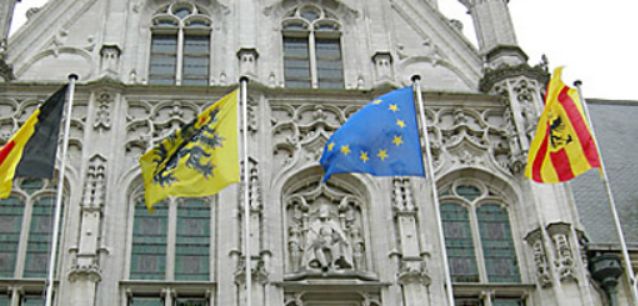
As Holy Roman
emperor, Charles V is a figure who is in many ways evocative of the Roman
emperor Heraclius. Heraclius failed to recognize the weakness of his empire in
the wake of the Persian war and then proceeded to alienate many of the subjects
who returned to his sway after years of Persian rule. If he had realized that
he needed to negotiate his authority rather than impose it, the door to the
Arab conquest might not have opened. Charles’ open contempt for his German
subjects and his evident weakness in the face of the challenge of the Ottoman
state invited revolt. Like Muhammad, Luther emerged from the context of a
religious reform movement to play a crucial role in uniting opposition to the
status quo. Also, like Muhammad, he did not shape the state that emerged as a
result of his preaching, that was left to others who took his ideas in
directions that he often did not approve of. His poor relationship with Henry
VIII is a case in point.
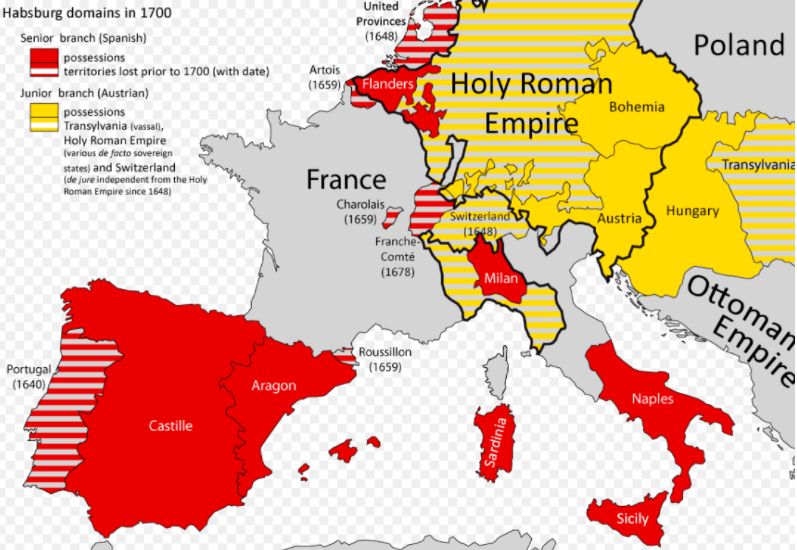
Like Heraclius,
Charles V was a decent general, but he could not recognize that victory on the
battlefield was insufficient to ensure a political result. Heraclius and
Charles were not the only people to have this problem. The bloody course of
European history after Charles’ abdication led to even greater changes. The
principles of royal absolutism were now undermined by thinkers who would study
the classical texts of the Middle Ages to be recovered by the humanists of the
previous century. The ability to control media, the key to Luther’s initial
success, will remain a critical aspect of disruptions to come. The
dissemination of ideas beyond the reach of government censorship will be a
crucial factor in the development of new ways to analyze society and new
concepts about the nature of authority. The Reformation demonstrated once and
for all that efforts to repress modernity with the tools of medievalism.
For updates click homepage here